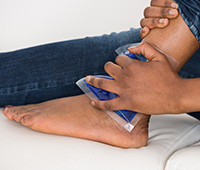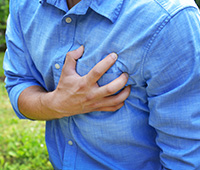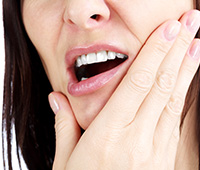WHAT IS Muscle Pain
- Definition
- Causes
- Symptoms
- Diagnosis
- Ayurvedic Tips
- FAQS
- References
Definition

Muscle pain is usually caused due to tension, overuse, or muscle injury from exercise or physically demanding work. Muscle pains are common, and can be experienced in more than one muscle at the same time. Sometimes, muscles also pain due to the soft tissues (include ligaments, tendons, etc) that surround them.1

Muscle pain also can be a hidden sign of conditions that may be affecting your entire body. For example, some infections (including the flu) and diseases that affect soft tissues throughout the body (such as lupus) can cause muscle pain.2
According to Ayurveda, this clinical condition can be compared with Angamardha (body ache) and this condition is in many conditions like related to Arthritis (Amavata, vatarakta, Sandi vata etc..,) In all these conditions the common factor involved Mandagni (low digestive fire).3,4
Disclaimer: The information on this page is not intended to be a substitute for professional medical advice. Do not use this information to diagnose or ayurvedic treatment of pain and/or muscle pain without consulting the doctor. Consult your physician before beginning an exercise regime. "While we have products /ayurvedic medicines for pain and/or muscle pain, you must consult an authorized physician before taking any of the products. For more information on products, visit www.dabur.com or call 1800-103-1644"
Causes
Causes OF Muscle Pain
Most common cause of muscle aches and pain is fibromyalgia, a condition that causes tenderness in your muscles and surrounding soft tissue, sleep difficulties, tiredness and headaches.2
In Ayurveda, fibromyalgia can be compared with the symptom Angamarda (body ache), which is caused due to two major reasons:3,4
1) Disturbance in nervous system function (Vata dosha imbalance in ayurveda) and,
2) An accumulation of toxins and blockages (ama) in the body due to low digestive fire (mandagni).
As the nervous system become less stable, toxins accumulate forming the ground for fibromyalgia. Once these imbalances reach a critical level, often a further stressful experience or event in a person’s life triggers the onset of fibromyalgia symptoms. When the individual becomes more balanced and rested, the symptoms subside but when the individual has stressful events, poor sleep, poor diet etc., the symptoms flare up again.
Other common causes of muscle pain are: 2
- Injury to the muscles, including sprains and strains
- Overuse of muscle
- Too much muscle tension or stress
- Arthritis (swelling of joints)
- Infections in the muscles
Disclaimer: The information on this page is not intended to be a substitute for professional medical advice. Do not use this information to diagnose or ayurvedic treatment of pain and/or muscle pain without consulting the doctor. Consult your physician before beginning an exercise regime. "While we have products /ayurvedic medicines for pain and/or muscle pain, you must consult an authorized physician before taking any of the products. For more information on products, visit www.dabur.com or call 1800-103-1644"
Symptoms
Symptoms OF Muscle Pain
Apart from muscle pain and tiredness, some common symptoms of fibromyalgia are:5
- Trouble sleeping
- Morning stiffness
- Headaches
- Painful menstruation among women
- Tingling or numbness in hands and feet
- Problems with thinking and memory (sometimes called "fibro fog")
Disclaimer: The information on this page is not intended to be a substitute for professional medical advice. Do not use this information to diagnose or ayurvedic treatment of pain and/or muscle pain without consulting the doctor. Consult your physician before beginning an exercise regime. "While we have products /ayurvedic medicines for pain and/or muscle pain, you must consult an authorized physician before taking any of the products. For more information on products, visit www.dabur.com or call 1800-103-1644"
Diagnosis
Diagnosis OF Muscle Pain
There is no particular test to diagnose fibromyalgia. Your doctor will rely only on your symptoms to make a diagnosis. Some of the most common diagnosis symptoms that doctors follow are:6
- Widespread muscle pain lasting at least three months
- Presence of other symptoms such as tiredness, waking up exhausted & trouble thinking
- No other underlying condition that might be causing the symptoms
Disclaimer: The information on this page is not intended to be a substitute for professional medical advice. Do not use this information to diagnose or ayurvedic treatment of pain and/or muscle pain without consulting the doctor. Consult your physician before beginning an exercise regime. "While we have products /ayurvedic medicines for pain and/or muscle pain, you must consult an authorized physician before taking any of the products. For more information on products, visit www.dabur.com or call 1800-103-1644"
Ayurvedic Tips
Ayurvedic Tips Muscle Pain
There is no particular test to diagnose fibromyalgia. Your doctor will rely only on your symptoms to make a diagnosis. Some of the most common diagnosis symptoms that doctors follow are:6
- Widespread muscle pain lasting at least three months
- Presence of other symptoms such as tiredness, waking up exhausted & trouble thinking
- No other underlying condition that might be causing the symptoms
Diet Recommendations (Aahar)
Ayurveda focusses on treating the aggravation of Vata dosha and accumulation of Ama (toxins) which are the primary causes of muscle pains. Ayurvedic treatment tacles the associated symptoms like weak digestion, constipation, insomnia and effects of chronic stress.3
Following is the diet suggested if you are suffering from fibromyalgia:3
- Vegetable juices and soups
- Coconut water and coconut milk
- Juice of carrot, cucumber, beet root
- Cooked vegetables like squash, zucchini and pumpkin
- Spices like cumin, coriander, ginger, asafetida, garlic, fennel and turmeric.
- Green salad with a dressing of lemon juice and a little salt
- Khichadi (recipe made by cooking rice and mung dal, 1:1 or 1:2 proportion)
Lifestyle changes (Vihar)
Meditation, Yoga and Pranayama are all recommended for supporting personal healing and relaxation of the mind. Various stretching exercises are known to have a positive effect on fibromyalgia. Regularity in our daily routine is helpful in reducing vata imbalance.
Recommended Yoga Asanas for Fibromyalgia and related problems are:7 (Consult your doctor before practising Yoga. Yoga should be done unde thetrained yoga instructor)
Pain
 Surya namaskar
Surya namaskar Vinyasa
Vinyasa
Stiffness of muscles
 Bitilasana-marjariasana (Cat & Cow pose)
Bitilasana-marjariasana (Cat & Cow pose)
Sleep disturbance

 Supta baddha konasana B alasana (child’s pose)
Supta baddha konasana B alasana (child’s pose) Headaches
Headaches Uttanasana Adho mukha svanasana
Uttanasana Adho mukha svanasana
Disclaimer: The information on this page is not intended to be a substitute for professional medical advice. Do not use this information to diagnose or ayurvedic treatment of pain and/or muscle pain without consulting the doctor. Consult your physician before beginning an exercise regime. "While we have products /ayurvedic medicines for pain and/or muscle pain, you must consult an authorized physician before taking any of the products. For more information on products, visit www.dabur.com or call 1800-103-1644"
FAQS
FAQS
1. Can Ayurveda treat foot pain?
In Ayurveda, foot care is considered very important since it is known to benefit the entire body and nervous system in a holistic manner. There are certain points in our body called marma or vital points, where our vital energies are concentrated. Feet and ankles also have these vital points, which if not taken care of, can cause problems like chronic pain in the ankles, pain and swelling in feet, etc. Ayurveda can play a significant role in managing ankle pain with a combination of corrective Ahar (diet), Vihar (exercise) and Aushadhi (Medicines) regime.
2. What kind of diet and exercises will be helpful in reducing neck pain?
To reduce neck pain, Ayurveda suggests following diet and exercises:
- Take lots of fruits, green vegetable salads and sprouts.
- Good hydration will help retain neck health.
- Avoid refined foods and junk foods.
- Milk is an important source of Calcium and can help maintain healthy bones.
- Vitamin C in citrus fruits will help the healing process.
- Honey in warm water or herbal teas are good for cleansing the bowels and this will help relieve many backaches that are due to constipation.
Pranayama (breathing exercises) is a powerful way to promote relaxation and a pivotal first step towards relieving muscle tension. Slow, deep breathing & relaxation can stimulate a sense of calmness and cause reduction in pain.
Yoga Asanas are also beneficial in maintaining neck and overall health
- Balasana
- Marjaryasana
- Bhujangasana
3. I have knee pain. What could be the reasons for it?
Knee pain can have different causes. Being overweight puts you at greater risk for knee problems. Overusing your knee can trigger knee problems that cause pain. If you have a history of arthritis (swelling of knee joint), it could also cause knee pain.
Medical conditions that can cause knee pain are
- Arthritis – Rheumatoid arthritis, Osteoarthritis, Gout
- Infection in the knees / knee joint
- Injuries – fracture, dislocation, sprained knees etc.
- Cancer
4. What can I do to reduce my knee pain?
Ayurveda suggests following diet and lifestyle changes to help reduce knee pain.
Include more foods containing
- Pulses: Black gram, green gram
- Vegetables & spices: Onion, garlic, sesame seeds, ginger, radish, ladies finger, pumpkin
- Fruits: pomegranate, mango, grapes
- Oils: Ghee
Ayurveda recommends regular, slow and gentle exercises with adequate rest to knee joints. Regular Pranayama and Yoga Nidra is also recommended.
- Avoid prolonged walking, standing, kneeling and squatting and crossed leg sitting.
- Yoga asanas: Makarasana, Pavanamuktasana, Dhanurasana, Vakrasana
5. I have tingling pain in the legs. Is it sciatica?
Sciatic pain most often occurs on one side of leg or hip. Symptoms of sciatica pain can vary widely as mentioned below:
- Mild tingling
- Dull aching that radiates from buttock to back of whole leg
- Burning sensation
- Inability to move leg when pain becomes severe
The pain often starts slowly and may get worse:
- After standing or sitting
- At night
- When sneezing, coughing, or laughing
6. What diet is effective in reducing the sciatica pain?
A healthy diet for controlling sciatica pain is for balancing Vata dosha and includes:
- Grains: Rice, cooked oatmeal, whole wheat and whole grain breads (toasted)
- Pulses: Yellow split mung beans (green skin removed), whole mung beans, red lentils and tofu
- Vegetables: : Zucchini, asparagus, carrot, beets, sweet potatoes, cucumber, lady finger, parsley, green peas, fennel, spinach in small amounts and cooked coconut. All should be cooked well so they are soft.
- Spices: Cumin, ginger, mustard seeds, ajwain, celery seeds, fenugreek, coriander, bay leaves, basil, saffron, hing (asafoetida), cinnamon, cardamom, cloves, anise, fennel, black pepper (in small amounts)
- Fruits: All ripe, sweet, and juicy fruits. Sweet grapes, banana, melons, plums, cherries, mango, papaya, pomegranate, sweet pineapples, raisins, sweet oranges, dates and figs, avocado, apples and pears.
- Oils: Ghee or organic olive oil
- Sweeteners: Honey, jaggery, date sugar
7. I frequently get gas pain. What food types are good for me?
Following foods are good to help relieve gas pain:
- Grains: Whole wheat thick flat bread or chapati, millet & sorghum bhakri, unpolished rice
- Pulses: Chickpea, Tur dal, Masoor Moong
- Vegetables: Carrots, Radish, Lauki, potatoes, white gourd, spiny gourd, , cucumber, ajwain, guar bean, eggplant, amaranth, cabbage, spinach, coriander seeds and leaves, sweet potatoes, tomatoes, green chillies, lady finger
- Fruits: , pears, papaya, pineapple, pomegranate, oranges, unripe bananas, water chestnut, dry fruits – almonds, walnuts, peanuts, dry dates, apples, grapes etc.
- Oils: Ghee, coconut oil in small quantities
- Ginger, cumin, coriander should be preffered in spices.
8. What is trigeminal neuralgia?
Trigeminal nerve (TN) pain is a nerve condition that causes a stabbing or electric-shock-like pain in parts of the face.
It usually affects one side of the face. Any vibration on your face, even from talking, brushing etc. can set it off. The condition may come and go, disappearing for days or even months. But the longer you have it, the less often it goes away. TN pain usually affects women and people above 50 years of age.
Ayurveda describes 11 types of shiro rogas (headaches), among which trigeminal nerve type of pain is called ‘Ardhavabhedaka’. It happens when aggravated doshas (Vata, Pitta and Kapha) press on the neck and throat producing a powerful burning sensation, out of which comes excruciating pain. This pain ultimately affects the eyes, eyebrows and temples.
9. How can Ayurveda help in relieving stomach pain?
Ayurveda describes a comprehensive approach towards managing stomach pain- the most commonly diagnosed conditions being constipation (Vibandha) and indigestion (Ajirna)
Constipation is used to indicate fewer bowel movements, hard stools, painful defection and feeling of bloating, abdominal pain or incomplete elimination.
Indigestion, on the other hand, is an abnormality that occurs in digesting food or lack of proper digestion resulting in stomach pain, burping or flatulance (abdominal gas).
Ayurveda can play a significant role in managing & preventing different stomach pains by practising a combination of corrective Ahar (diet), Vihar (exercise) and Aushadhi (Medicines) regime
Corrective Ahar for both constipation & indigestion includes:
Grains: Wheat, unpolished rice, barley
- Pulses: Green gram, chickpeas, course corn, Toor dal, moong, masura lentils, Vegetables/Spices: Garlic, Asafetida, long pepper, sunthi (dry ginger), green leafy vegetables, cucumber, bitter gourd, pointed gourd, cabbage, dates, betel nut, turmeric
- Fruits: High fibre fruits such as apples, pears, papaya, grapes, amala, haritaki
- Oils: Ghee
Exercise: Regular exercise, meditation and practice of asanas purifies the blood, improves the appetite, increases the will power and makes the patient physically active. The whole alimentary canal improves and becomes regular.
Yoga Asanas: Vajrasana (after every meal), Kurmasana, Vakrasana, Katichakrasana
Pranayama: Surya anulom viloma, deep relaxation technique
10. What is myofasial pain?
Myofascial pain disorder (MPS) refers to pain and swelling in the body's soft tissues or muscles. Myofascial pain is a long-term, painful condition that affects the connective tissue that cover the muscles. It is considered as a type of muscular pain (fibromyalgia) which happens at specific areas on the body.
Myofascial pain might involve either a single muscle or an entire muscle group. In some cases, the area where you experience the pain might not be where the myofascial pain is generated. The actual location of the injury leads to the development of a trigger point, which in turn causes pain in other areas. This is known as referred pain
Disclaimer: The information on this page is not intended to be a substitute for professional medical advice. Do not use this information to diagnose or ayurvedic treatment of pain and/or muscle pain without consulting the doctor. Consult your physician before beginning an exercise regime. "While we have products /ayurvedic medicines for pain and/or muscle pain, you must consult an authorized physician before taking any of the products. For more information on products, visit www.dabur.com or call 1800-103-1644"
References
References
- Muscle Pain. NIH U.S National Library of Medicine. [document on the internet]. [Cited 2016 August 29]. Available at: https://medlineplus.gov/ency/imagepages/19676.htm
- Muscle Aches. NIH U.S National Library of Medicine. [document on the internet]. [Cited 2016 August 29]. Available at: https://medlineplus.gov/ency/article/003178.htm
- Brachtl C. Fibromyalgia & Ayurveda. [document on the internet]. [Cited 2016 August 29]. Available at: http://www.jivaka.com/org/docs/paper/Brachtl%20Paper.pdf
- Kadam R et al. Fibromyalgia W.S.R to Amavata – An Ayurvedic Perspective. IAMJ: Volume 3; Issue 1; January – 2015.176-180.
- Fibromyalgia. NIH U.S National Library of Medicine. [document on the internet]. [Cited 2016 August 29]. Available at: https://medlineplus.gov/fibromyalgia.html
- Hennard J. A Protocol and Pilot Study for Managing Fibromyalgia with Yoga and Meditation. International Journal of Yoga Therapy – No. 21 (2011). 109-120.
Disclaimer: The information on this page is not intended to be a substitute for professional medical advice. Do not use this information to diagnose or ayurvedic treatment of pain and/or muscle pain without consulting the doctor. Consult your physician before beginning an exercise regime. "While we have products /ayurvedic medicines for pain and/or muscle pain, you must consult an authorized physician before taking any of the products. For more information on products, visit www.dabur.com or call 1800-103-1644"




